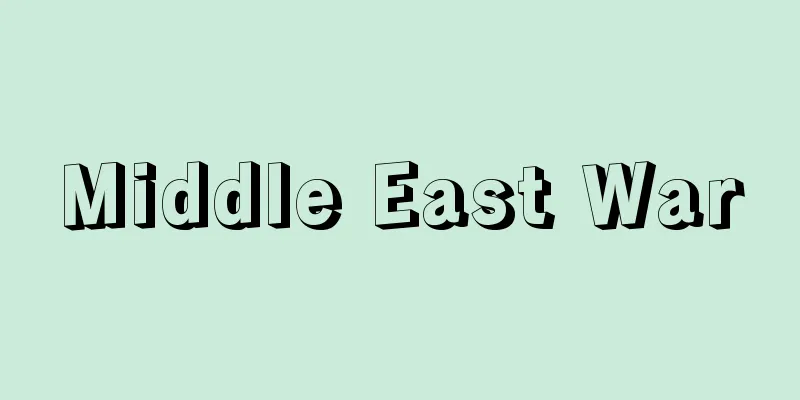Middle East War

|
Armed conflict between Arab countries and Israel that began with the establishment of the State of Israel in 1948. Also known as the Arab-Israeli conflict. There have been four major battles in the past: the First Arab-Israeli War (1948-49, Palestine War), the Second Arab-Israeli War (1956, Suez War), the Third Arab-Israeli War (1967, Six-Day War), and the Fourth Arab-Israeli War (1973, Ramadan War, known as the Yom Kippur War by the Israeli side). In other periods, battles have continued in various forms almost continuously. Large-scale fighting came to a halt after the Fourth Arab-Israeli War, and the idea of "Middle East Peace" aimed at national coexistence between Arab countries and Israel became important. In parallel with these changes in the situation, the Palestinian guerilla struggle against Israel, which began after the Third Arab-Israeli War, intensified, and Arab countries strengthened their oppression of Palestinians (Black September incident by the Jordanian government in 1970, attacks on Palestinian commandos by the Syrian army in 1976 and 1984-85 during the Lebanese civil war), leading to situations in which Arab countries and Israel joined forces to attack Palestinian armed struggle. Furthermore, fighting in the Middle East has also taken place as intra-Arab wars, such as the Lebanese civil war (1975-) and the Iran-Iraq war (1980-), and the Middle East wars can no longer be viewed as "Arab countries versus Israel." Just because relations between Arab countries and Israel are being pursued through "Middle East peace" rather than armed conflict does not necessarily mean that peace in the Middle East is in sight, and it can be said that both the "Middle East war" and the "Middle East peace" are given meaning primarily in the context of international politics surrounding the Middle East. Dismissing the fixed framework of "Arab countries versus Israel," I would like to first reconsider what the "Middle East war" was at the time of Israel's establishment. [Susumu Fujita] Israel and the Middle EastWhat problems did the establishment of the State of Israel in 1948 pose for the Arab world? The Zionist movement (which was born among Eastern European Jews in the late 19th century) aimed to establish a "Jewish state" in Palestine, and received a British guarantee (the "Balfour Declaration") during World War I. In Palestine, which became a British Mandate, Jewish settlers and Arab farmland were purchased to build settlements. In particular, against the backdrop of the intensification of the Nazism's hunt for Jews in Europe in the 1930s, settlement construction accelerated, and by the end of World War II, the settlements had expanded to the point where they had become the actual "Jewish state" (Jewish settlers made up 30.83% of the Palestinian population in 1945-46, and Jewish-owned land accounted for 5.67% of the entire territory of Palestine). The Zionist movement achieved recognition from the United Nations, and the "Jewish state" that was realized as a result was Israel. The November 1947 UN Partition Resolution for Palestine recognized the national independence of both the Arabs and the Jews, and resolved to divide Palestine into the territories of these two independent states after the end of the Mandate. The UN considered the Jews, who were mainly settlers, to be the "people of Palestine," and recognized the "Jewish state" as an actual state, allocating them 60% of Palestine as their national territory, far exceeding the existing settlements. However, the Zionist movement was a nation-building movement only for Jews, and the Arab people of Palestine knew very well from their experience of conflict with the settlers that a "Jewish state" would inevitably lead to the exclusion of non-Jewish Arabs. Britain recognized the Zionist movement in order to use it to divide the Palestinian people and to prevent Arab national independence. The Zionist nation-building movement was opposed to the path of Arab national independence sought by all Palestinian residents, including the indigenous Jews (separate from the settlers), and intended to expel the Arab people from Palestine. The armed conflict between the Arabs and the settlers caused by the Zionist movement brought the British Mandate itself to collapse, and the UN resolution that "resolved" the armed conflict on behalf of Britain was the partition resolution mentioned above. By recognizing the "Jewish state" as a settler state, the UN resolution rejected the Arab demand for Palestinian independence and risked expulsion from their homeland. In the 19th century, when the decline of the Ottoman Empire caused unrest in the Middle East, European countries, seeing the importance of the Middle East's strategic position and resources (especially oil), focused on the religious and ethnic diversity of Middle Eastern society and used this to incite internal division and conflict in the Middle East. With the collapse of the Ottoman Empire after World War I, the Asian region of the former empire was divided by European countries, and the Arab region was organized into a group of mandated states by the United Kingdom and France. Each Arab country had ambitions for unified control of the Arab region (Greater Syrianism, the Fertile Crescent concept, etc.) or aspired to become a "Christian nation" (Lebanon), which furthered division and conflict within the Arab world. In this way, the prototype of today's Middle East was created, where a group of disparate countries with different political, economic and social systems were organized together under the control of a major European power. From the end of World War II, movements demanding domestic change (Greece, Turkey), independence movements in Arab countries, and independence movements by ethnic minorities (Azerbaijanis, Kurds) intensified in various parts of the Middle East, and while an "East-West conflict" situation dominated international politics at the time, the United States, replacing Britain and France, which had been significantly weakened after the war, began to provide strong military and economic aid (the Truman Doctrine, the Marshall Plan) and seek to avert a "crisis situation" in the Middle East (the Middle East problem). By establishing a "Jewish state" in Palestine, a corner of the Middle East, America and Western Europe aimed to have the state, driven by a desire to monopolize the holy lands (of the three major religions) and to fight against the Arabs, oppose the development of national movements in Arab countries under the pretext of "national security," and to promote internal division and conflict in the Middle East. By doing so, America and Western Europe hoped to gain stable control over the Middle East, which had become a strategic and economic stronghold. The establishment of the state of Israel not only gave rise to a new Middle Eastern problem, the "expulsion of Palestine and the Arab world," but also signified the Middle East becoming a "conflict zone" with the emergence of anti-Arab nations. The Middle East wars that began with the establishment of Israel were characterized as interventionist wars between Israel, a "European colony," and the United States and Western Europe, all of whom aimed to thwart the national movements of Arab nations. This was the structural factor that led to the Middle East wars becoming a regular occurrence in the Middle East after World War II. [Susumu Fujita] The development of the Middle East warIn the First Arab-Israeli War, which began with the establishment of Israel, Palestinians and volunteer troops from Arab countries, who faced the risk of expulsion, were excluded from the ranks soon after joining the war, and the war unfolded as an "Arab countries versus Israel" scenario. The Arab armies were not united due to their different aims, and weapons were under British control in all countries, so the war progressed with Israel having an overwhelming advantage. In 1949, a ceasefire agreement was signed between Israel and each of the Arab countries that participated in the war, and Palestine was divided between Israel, Egypt, and Jordan, and Israel acquired Palestinian territory that far exceeded the UN partition resolution. The Israeli state transferred the vast amount of land, houses, and graveyards of Arab residents that it had confiscated during the war to the state, regarding them as "uninhabited real estate" (Absentee Property Law of 1949), and prevented residents who had fled to neighboring Arab countries from returning home. This led to the decision to expel Palestinians and turn them into refugees. Immediately after the First Arab-Israeli War, Arab countries were engulfed in a storm of Arab nationalism seeking complete national independence and social change, and in response, the United States, Britain, France, and Israel built a system of intervention in Arab countries.While restricting arms supplies to both Arabs and Israel (the 1950 Tripartite Declaration of the United States, Britain, and France), the United States continued to provide strong aid to Israel, and the US and Britain's pan-Middle East military alliance (the Middle East Defense Command concept, the Baghdad Pact, etc.) aimed its guns at revolutions in Arab countries in the name of "anti-communism." The Second Arab-Israeli War (see Suez War) broke out when the Egyptian Revolution (1952) led to the nationalization of the Suez Canal (1956), and took the form of an intervention war in Egypt by Israel, Britain, and France, which was intended to thwart the role of the revolution in uniting the Arab peoples and to expand Israel's territory. As a result of this war, Britain and France's influence in the Middle East declined decisively, and Arab nationalism was on the rise while aiming for socialism (the Iraqi Revolution, the crises in Lebanon and Jordan, the movement to merge Egypt and Syria, etc.), the United States began to build a system to put a stop to Arab nationalism, centering on Arab monarchies. In the 1960s, amid the Yemeni Revolution and the rise of socialist trends in Arab countries, the conflict between the "progressive regimes" and the "Islamic alliance" in the Arab world intensified, and the conflict between the two sides intensified abnormally with the establishment of a left-wing Ba'ath Party government in Syria in 1966, the Jordanian crisis, and the conclusion of the Egyptian-Syrian joint defense treaty. Taking advantage of this opportunity, Israel strengthened its military attacks on Syria under the pretext of fighting Palestinian guerrilla activities, Egypt and Syria prepared for joint defense against Israel, and various countries, led by the United States, made international demands on both countries for "free navigation in international waterways" and "right to the survival of nations." In this situation, Israel launched a full-scale invasion of neighboring Arab countries in June 1967 (the Third Arab-Israeli War). Israel took control of the Sinai Peninsula and the West Bank (including occupying the holy city of Jerusalem), and also occupied the Golan Heights in Syria. The Arab "progressive regime" suffered a serious blow, and the adoption of UN Resolution 242 in November 1967 set out guidelines for the subsequent "Middle East Peace," guaranteeing the right to exist for all countries in the Middle East, including Israel (denying the right to self-determination for the Palestinian people), and calling for the withdrawal of Israeli troops from occupied territories, which were accepted by Jordan and Egypt. Israel gained control of vast swaths of occupied territory, including the entirety of Palestine, and took in a large number of Arab Palestinian residents. As a result, it became difficult for Arab countries to deny the existence of Israel as a nation, and the US-led "Middle East Peace" initiative began to move forward, beginning with the Rogers Proposal (1970). The Yom Kippur War in October 1973, which was a surprise attack by the Arab side and the oil strategy of Arab oil-producing countries, brought about the return of the Sinai Peninsula, but this also played a major role in giving impetus to the revitalization of the "Middle East Peace" movement, and Israel signed troop disengagement agreements with Egypt (1974, 1975) and Syria (1974), and managed to conclude peace agreements with Egypt in 1982 and with Lebanon in 1983 (the peace agreement with Lebanon was abolished in 1984), effectively bringing an end to the Middle East war as an armed conflict between "Arab countries and Israel." However, after the Third Arab-Israeli War, the military struggle of Palestinian "refugees" began in Arab countries and Israeli occupied territories, demanding the right of self-determination for the Palestinian people, and with the growing support of international public opinion, it became the biggest obstacle to "Middle East peace." In the 1970s, a time of Arab oil boom and Middle Eastern economic development, poor people in refugee camps around Arab cities and in slums filled with migrant workers also came to the surface, uniting beyond religious and ethnic differences to rise up against a state of no rights. The trend of popular movements that developed beyond the control of the state (urban riots in the Gulf countries and Egypt, the Lebanese civil war, popular resistance in the occupied Palestinian territories and refugee camps, and the Islamic Revolution in Iran) is destabilizing the systemic stability of Middle Eastern countries and once again accelerating the "Middle East crisis" situation. [Susumu Fujita] "What is the Palestinian Problem?" (1982, Miraisha), edited by Citizens' Council for Peace in the Middle East ; "The History of the Palestinians," by D. Gilmore, translated by Kitamura Fumio (1985, Shinhyoron) ; "Documents of Modern History 13: Arab Liberation," edited by Itagaki Yuzo (1974, Heibonsha) ; "Arabs in Israel," by S. Jellis, translated by Wakaichi Mitsuji and Naramoto Eisuke (1975, Simul Publishing Co.) [References] | |©Shogakukan "> Israeli occupied territories in the Middle East wars Source: Shogakukan Encyclopedia Nipponica About Encyclopedia Nipponica Information | Legend |
|
1948年のイスラエル国家成立で始まったアラブ諸国とイスラエルとの間の武力衝突。アラブ・イスラエル紛争ともいう。これまでに大規模な戦闘局面は第一次中東戦争(1948~49、パレスチナ戦争)、第二次中東戦争(1956、スエズ戦争)、第三次中東戦争(1967、六日戦争)、第四次中東戦争(1973、ラマダーン戦争、イスラエル側ではヨーム・キップール戦争とよぶ)の4回を数えるが、それ以外の時期も戦闘はさまざまな形でほぼ連続して行われた。 大規模戦闘は、第四次中東戦争を最後として停止し、アラブ諸国とイスラエルとの国家的共存を目ざす「中東和平」構想が重要性をもつに至った。そうした事態の変化に並行して、第三次中東戦争以降開始されたパレスチナ人の対イスラエル・ゲリラ闘争が高まりをみせ、アラブ諸国の側がパレスチナ人に対する弾圧を強化して(1970年ヨルダン政府による黒い9月事件、1976年・84~85年レバノン内戦におけるシリア軍のパレスチナ・コマンド攻撃など)、アラブ諸国とイスラエルとがパレスチナ人武装闘争にいっしょになって攻撃するといった状況も生じてきた。さらに中東の戦闘状況は、レバノン内戦(1975~)、イラン・イラク戦争(1980~)といったアラブ内戦争としても生じており、もはや「アラブ諸国対イスラエル」の図式で中東戦争をとらえることはできなくなった。 アラブ諸国とイスラエルの関係が武力衝突によらず「中東和平」によって模索されているからといって中東の平和はかならずしも展望されておらず、「中東戦争」「中東和平」の双方が、もっぱら中東をめぐる国際政治のなかで意味づけられているといえよう。「アラブ諸国対イスラエル」の固定的枠組みを排して、以下ではまずイスラエル成立時「中東戦争」とは何であったのかを検討し直してみることにしたい。 [藤田 進] イスラエルと中東1948年のイスラエル国家成立は、どのような問題をアラブに投げかけていたのだろうか。 パレスチナに「ユダヤ人国家」建設を目ざすシオニズム運動(19世紀後半に東欧のユダヤ人たちの間から誕生)は、第一次世界大戦中にイギリスの保証(「バルフォア宣言」)を得、イギリス委任統治領となったパレスチナでユダヤ人入植とアラブ農地買上げとによる入植地建設を展開した。とくに1930年代ヨーロッパでのナチズムのユダヤ人狩りが激化したのを背景に、入植地建設は急ピッチとなり、第二次大戦終了時には入植地は「ユダヤ人国家」の実体をなすまでに拡大した(1945~46年にユダヤ人入植者はパレスチナ人口の30.83%、ユダヤ人所有地はパレスチナ全土の5.67%)。シオニズム運動の実績は国際連合の承認を得、その結果実現した「ユダヤ人国家」がイスラエルであった。1947年11月国連パレスチナ分割決議は、アラブ・ユダヤ双方の民族独立を認め、委任統治終了後のパレスチナを両独立国の領土として分割することを決議した。国連は入植者中心のユダヤ人を「パレスチナの民族」とみなし「ユダヤ人国家」を実際の国家と認めて、既得入植地をはるかにしのぐパレスチナの6割相当を国土として割り当てた。 だがシオニズム運動がユダヤ教徒だけによる国づくり運動であり、「ユダヤ人国家」が非ユダヤ教徒アラブの排除を必然化することを、パレスチナのアラブ住民は入植者との衝突の体験から熟知していた。イギリスがシオニズム運動を認めたのは、同運動をパレスチナ住民内部の分裂、アラブ民族独立阻止に利用するためであった。シオニズムの国づくり運動は、土着ユダヤ教徒(入植者とは別)を含むパレスチナ全住民の求めるアラブ民族独立の道に敵対し、アラブ住民のパレスチナ放逐を意図していた。シオニズム運動が引き起こすアラブと入植者との間の武力衝突はイギリス委任統治自体を破局に追い込み、イギリスにかわって武力衝突の「解決」にあたった国連の決議案が、先にみた分割決議であった。国連決議は、入植者国家たる「ユダヤ人国家」を承認したことによって、パレスチナのアラブ独立の要求を退け、彼らの祖国からの放逐の危険性を招いた。 オスマン帝国衰退で中東社会が動揺をきたす19世紀、中東の戦略的地位の重要性や資源の重要性(とくに石油)をにらむヨーロッパ諸国は、中東社会のもつ宗教的・民族的多様性に着目、それを利用して中東を内部分裂・対立へと扇動していった。第一次大戦後オスマン帝国解体で、旧帝国領アジア地域はヨーロッパ諸国により分割され、アラブ地域は英・仏の委任統治国群に編成された。アラブ諸国はそれぞれにアラブ地域の一円的支配の野望を抱いたり(大シリア主義、肥沃(ひよく)な三日月地帯構想など)、「キリスト教徒国家」の意欲を抱いたり(レバノン)で、アラブ内分裂・対立を助長した。こうして、政治体制、経済・社会体制の異なるばらばらな国家群がヨーロッパ大国の支配下に一体となって編成される、今日の中東地域の原型ができあがった。 第二次大戦末期から中東諸地域では、国内変革要求運動(ギリシア、トルコ)、アラブ諸国独立運動、少数民族独立運動(アゼルバイジャン人、クルド人)が激化し、おりから「東西対立」的状況が国際政治を支配するなか、大戦後弱体化の著しい英・仏にかわってアメリカが強力な軍事・経済援助(トルーマン・ドクトリン、マーシャル・プラン)を発動して中東の「危機的事態」(中東問題)回避に乗り出していた。 中東の一角パレスチナに「ユダヤ人国家」を据えることによりアメリカ・西欧は、(三大宗教の)聖地独占とアラブ対決との意欲に駆られる同国家が、アラブ諸国内の民族運動の発展に「国家の安全」を盾に敵対し、中東内部分裂・対立を助長することをねらった。そのことによってアメリカ・西欧は、戦略的・経済的要衝と化した中東の安定的支配を期待した。 イスラエル国家成立は、「パレスチナ・アラブ放逐」という新たな中東問題を派生させたばかりか、反アラブ国家の登場による中東の「紛争地域化」を意味した。イスラエル成立で開始された中東戦争は、「ヨーロッパの植民地」イスラエルと、アメリカ・西欧とによる、アラブ諸国の民族運動阻止のための干渉戦争としての性格をもっていた。ここに、中東戦争が第二次大戦後の中東の恒常的事態となる構造的要因があった。 [藤田 進] 中東戦争の展開イスラエル成立で始まった第一次中東戦争で、追放の危機に直面するパレスチナ人およびアラブ諸国からの義勇軍は、参戦後まもなく戦列から締め出され、戦争は「アラブ諸国対イスラエル」の図式で展開した。アラブ諸国軍は各国の思惑が交錯して足並みが乱れ、武器は各国ともイギリスの管理下にあり、イスラエル側圧倒的優位のうちに戦局は進んだ。1949年イスラエルと各アラブ参戦国ごととの休戦協定で、パレスチナはイスラエル・エジプト・ヨルダン間に分割され、イスラエルは国連分割決議を大幅に上回るパレスチナ領を獲得した。イスラエル国家は戦争を通じて没収した膨大なアラブ住民の土地・家屋・墓地を「無人の不動産」とみなして国家に移管し(1949年不在者財産法)、戦禍を逃れ周辺アラブ諸国に避難した住民の帰国を阻止した。ここにパレスチナ人の追放・難民化が決定された。 第一次中東戦争直後からアラブ諸国が完全な民族独立や社会変革を志向するアラブ・ナショナリズムの嵐(あらし)に包まれるのと呼応して、米・英・仏・イスラエルは、アラブ諸国への干渉体制を築いていった。アラブ・イスラエル双方への武器供与制限(1950年米・英・仏三国宣言)の一方でアメリカは強力な対イスラエル援助を続け、米・英による全中東規模の軍事同盟(中東防衛司令部構想、バグダード条約機構など)は、「反共」の名目で銃口をアラブ諸国の革命に向けていた。 エジプト革命(1952)がスエズ運河国有化(1956)に結び付いた段階で起きた第二次中東戦争(「スエズ戦争」の項参照)は、イスラエル・英・仏三国のエジプト干渉戦争の形をとり、アラブ諸国民衆結束に果たす革命の役割阻止と、イスラエル領拡張とがあわせて企てられていた。この戦争の結果、中東での英・仏の影響力が決定的に後退し、アラブ・ナショナリズムが社会主義を志向しつつ高揚していくなかで(イラク革命、レバノン・ヨルダン両国危機、エジプト・シリア合併の動きなど)、アメリカはアラブ王制諸国を軸にアラブ・ナショナリズムに歯止めをかける体制づくりを開始した。 1960年代に入ってイエメン革命やアラブ諸国の社会主義諸潮流の高まりのなか、アラブ内の「進歩派体制」対「イスラム同盟」の対立が激化、66年シリアでバース党左派政権成立、ヨルダン王国危機、エジプト・シリア共同防衛条約締結などで両者の対立は異常に高まった。その機会をとらえて、イスラエルはパレスチナ人ゲリラ活動をたたくとの名目でシリアへの軍事的攻撃を強化、エジプト・シリアが対イスラエル共同防衛の構えをとり、アメリカを先頭とする各国が「国際水路の自由航行権」「国家の生存権」の国際的要求を両国に突きつけている状況下で、67年6月イスラエルの周辺アラブ諸国への全面的侵攻が開始された(第三次中東戦争)。イスラエルはシナイ半島およびヨルダン川西岸地区を制圧(聖地エルサレムも占領)、シリアのゴラン高原も占領した。 アラブ「進歩派体制」は深刻な打撃を被り、1967年11月の国連決議242号採択で、その後の「中東和平」の指針となる、イスラエルを含む中東域内諸国の生存権保障(パレスチナ人民族自決権の否定)、イスラエル軍の占領地撤退が示され、これをヨルダン、エジプトは受諾した。イスラエルはパレスチナ全土を含む広大な占領地をつかみ、多数のアラブ・パレスチナ住民を抱え込んだ。この結果、アラブ諸国はイスラエルの国家的存在を否定することは困難となり、ロジャース提案(1970)に始まるアメリカ主導の「中東和平」づくりが動きだした。 1973年10月の第四次中東戦争は、アラブ側の奇襲作戦とアラブ産油国の石油戦略によってシナイ半島返還をもたらしたが、これも「中東和平」活性化に弾みをつける役割が大きく、イスラエルはエジプト(1974、75)、シリア(1974)との間で兵力引き離し協定に調印、1982年対エジプト、83年対レバノンの両平和協定締結へとこぎ着け(対レバノン平和協定は84年破棄)、「アラブ諸国対イスラエル」の武力衝突としての中東戦争は事実上停止した。 だが第三次中東戦争以降、アラブ諸国やイスラエル占領地で開始されたパレスチナ「難民」の軍事闘争は、パレスチナ民族自決権要求を掲げ国際的世論の支持を強めつつ展開され、「中東和平」最大の障害となった。アラブ石油ブームと中東経済開発でわく1970年代、アラブ諸国都市周辺難民キャンプや出稼ぎ労働者で膨らんだ貧民スラムで、宗教や民族の違いを超えて貧民が結束し、無権利状態に抗して立ち上がる事態も表面化した。国家の支配を乗り越えて発展する民衆運動の潮流(湾岸諸国やエジプトの都市暴動、レバノン内戦、パレスチナ占領地や難民キャンプの民衆抵抗、イラン・イスラム革命)は、中東諸国の体制的安定を揺るがし、「中東危機」的事態をふたたび促進しているのである。 [藤田 進] 『中東の平和をもとめる市民会議編『パレスチナ問題とは何か』(1982・未来社)』▽『D・ギルモア著、北村文夫訳『パレスチナ人の歴史』(1985・新評論)』▽『板垣雄三編『ドキュメント現代史13 アラブの解放』(1974・平凡社)』▽『S・ジェリス著、若一光司・奈良本英佑訳『イスラエルのなかのアラブ人』(1975・サイマル出版会)』 [参照項目] | |©Shogakukan"> 中東戦争におけるイスラエルの占領地 出典 小学館 日本大百科全書(ニッポニカ)日本大百科全書(ニッポニカ)について 情報 | 凡例 |
Recommend
Parliamentaryism
A political ideology that holds that parliamentar...
Ch'ŏngamni‐p'aesa (English name)
The site of a Goguryeo temple from the Three Kingd...
Multi-purpose terminal - Fukugo Terminal
A terminal that combines the terminal functions of...
Arter - Arter
...The north, especially the Punjab region, has l...
Pawn shop - Shichiya
A business that lends money using goods (movables...
Sarapis
…A hybrid deity that clearly illustrates the reli...
Scleritis
…In severe myopia, the eye axis is elongated, the...
pederasty
...Homosexuality, which can be defined as sexual ...
Sea steps - Kaidan
… plateau A flat or nearly flat area of conside...
Sakae Akaiwa
Christian thinker and pastor. Born in Ehime Prefe...
Industrial relations - Industrial relations
The concept of labor-management relations was giv...
Japanese newt
A typical newt of the Trituridae family (illustrat...
Shigaraki Palace
One of the palaces of Emperor Shomu. It is also w...
Oloroso - Oloroso
…It is popular as an aperitif or digestif, especi...
Keith, A.
...He was a leading British anthropologist who wa...









